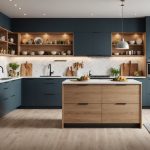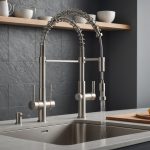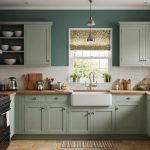Introduction to Under-Cabinet Lighting
Under-cabinet lighting is integral to modern kitchen aesthetics and functionality. As kitchen lighting trends continue to evolve in the UK, these lights stand out by filling spaces under cabinetry that are often shadowy and less functional. In today’s modern kitchen design, embracing such innovative solutions is key to both practicality and style.
Incorporating under-cabinet lighting enhances kitchen activities by providing focused illumination on countertops, ensuring precision in cooking and food preparation tasks. Furthermore, it highlights decorative features, adding layers to your kitchen’s visual appeal. By strategically installing these lights, homeowners can transform their kitchens, aligning them with contemporary design ideals that emphasise both form and function.
Also read : The Definitive Handbook for Selecting the Perfect Kitchen Faucet for Your Contemporary UK Home
Recent trends highlight a preference for streamlined, energy-efficient lighting solutions that marry aesthetic flexibility with usability. This trend speaks to the wider appeal of minimalistic designs that prioritize both beauty and efficiency in one of the home’s most vital spaces. Under-cabinet lighting not only upgrades the visual allure of the kitchen but also significantly boosts its overall functionality, making daily tasks simpler and more enjoyable. Embracing these innovations makes the kitchen a more inviting and efficient space for household activities.
Types of Under-Cabinet Lighting
When it comes to under-cabinet lighting, homeowners have various options to enhance kitchen efficiency and style. Each type offers unique benefits aligned with different preferences and needs.
In parallel : Discover trusted uk brands for sustainable, non-toxic kitchen storage solutions
LED Strip Lights
LED strip lights are a popular choice due to their energy efficiency and ability to produce bright, even illumination. They are known for their longevity, often lasting up to 50,000 hours. These lights offer aesthetic flexibility, easily fitting into varied kitchen designs without bulky installation hardware. With a spectrum of color temperatures, homeowners can choose options that suit their kitchen style, from warm whites to cool blues.
Puck Lights
Puck lights, named for their hockey puck-like shape, provide focused illumination ideal for highlighting specific countertop areas. They are versatile, allowing for surface mounting or recessing depending on the desired effect. Puck lights generally offer a warm glow, enhancing the kitchen’s inviting atmosphere. Their compact size makes them ideal for minimalist kitchen designs.
Fluorescent Lights
While less common today, fluorescent lights are another option. Known for their cost-effectiveness, they deliver consistent brightness and longevity. However, they generally offer cooler color temperatures, which can be beneficial for tasks requiring clear visibility.
Design Considerations
When planning under-cabinet lighting, integration with your overall kitchen design is crucial for achieving a harmonious look. To start, consider the lighting placement to ensure optimal impact and functionality. Good placement involves aligning lights directly above work areas, like countertops, to provide necessary task lighting, while maintaining a discreet presence within the overall kitchen decor.
Selecting the right color temperature is also significant. For traditional kitchens, a warm color temperature can amplify the cozy and inviting ambiance. In contrast, modern and minimalist designs often benefit from cool, white lighting that emphasizes clean lines and a sleek aesthetic. Colour temperature impacts not only the mood but also how textures and colors in the kitchen are perceived.
Design flexibility plays an essential role. Ensuring your lighting choice can adapt to evolving trends and personal tastes without requiring a comprehensive overhaul is valuable. Options like LED strip lighting offer customizable, bendable solutions suited for various design preferences. Maintain a balance between aesthetic appeal and functionality, considering both present design trends and potential future styles.
Installation Guides
Installing under-cabinet lighting significantly enhances kitchen functionality and ambiance, providing targeted illumination where it is most needed. Whether opting for a DIY approach or seeking professional installation, there are key considerations to ensure a successful setup.
DIY Installation Process
For those inclined to undertake a DIY lighting installation, success hinges on a thorough understanding of the steps involved. Begin by selecting an appropriate lighting type, such as LED strip lights, puck lights, or fluorescent options. Each type comes with its own installation nuances, so referencing manufacturer instructions is crucial. The installation process generally involves measuring the area to ensure a proper fit, cutting lights to the required size if applicable, and securing them in place with suitable adhesive or brackets.
Tools and Materials Needed
Preparing with the right tools and materials is essential. Common requirements include a tape measure, wire stripper, screwdriver, adhesive strips or mounting brackets, and a power drill. For certain lighting types, a transformer or adapter may also be necessary to connect to the power supply safely.
When to Hire a Professional
While DIY installation is feasible for many homeowners, some situations warrant hiring a professional. Complex layouts, lack of tools, or electrical work can benefit from expert assistance to avoid safety hazards and ensure optimal performance.
Enhancing Ambiance and Functionality
To create a truly inviting kitchen, incorporating under-cabinet lighting can significantly boost both ambiance and functionality. Such lighting effectively transforms workspaces, offering precise task lighting that’s critical for cooking, chopping, and other kitchen activities. By focusing light precisely where it’s needed, under-cabinet lighting alleviates common shadow issues on countertops.
The use of dimmers and controls can further elevate your kitchen experience. Dimmers allow you to adjust the intensity of the light, providing mood lighting options that range from bright task-oriented settings to softer, more ambient tones for relaxed evenings or entertaining. This flexibility ensures that your kitchen can adapt to different needs and times of day effortlessly.
Layering lighting is another powerful technique to enhance your kitchen’s atmosphere. By combining different lighting elements – such as ambient ceiling lights with strategic under-cabinet fixtures – you can establish a warm, cohesive setting that feels both stylish and practical. Whether you’re preparing a family meal or hosting guests, layered lighting provides a welcoming and efficient culinary environment. In summary, under-cabinet lighting serves as a dynamic tool in crafting an aesthetically pleasing and functional kitchen space.
Practical Examples and Case Studies
Exploring real-life applications of under-cabinet lighting can provide valuable insights into its transformative power in diverse kitchen settings. By examining successful installations, you can uncover methods to enhance your own kitchen space.
Modern UK Kitchens
In contemporary UK kitchens, under-cabinet lighting is a chic solution that blends seamlessly with streamlined designs. These installations often include LED strip lights, which provide energy-efficient, bright illumination, ideal for open-plan kitchens that prioritise minimalism and clarity.
Small Kitchen Solutions
For compact kitchens, leveraging puck lights offers strategic lighting without overwhelming the space. These small fixtures add functionality, directing light to essential areas such as countertops, enhancing both aesthetics and utility. Their compact size is perfect for creating functional workspaces in limited areas.
Transitional Styles
Infusing fluorescent lighting in transitional kitchen designs caters to both traditional and modern elements. This choice benefits spaces needing consistent, cool light for practical tasks while maintaining a comfortingly familiar atmosphere. Fluorescent lights often provide a cost-effective solution, bridging different design preferences.
By tailoring lighting choices to specific kitchen constraints and embracing versatile solutions, homeowners can achieve dramatic transformations that underscore both style and efficiency.
Maintenance and Care
Regular maintenance of under-cabinet lighting ensures optimal performance and extends the life of your lights. Routine checks should include cleaning to prevent dust buildup, which can obstruct light output and affect efficiency. Soft, damp cloths are ideal for wiping down lights, as harsh chemicals may damage them, especially in sensitive areas like connectors.
Troubleshooting is integral to maintaining lighting longevity. Common issues such as flickering lights or reduced brightness can often be traced to loose connections or faulty bulbs. Check for any disconnected wires or replace bulbs as needed to resolve these problems efficiently.
Ensuring longevity involves responsibly operating the lights and using them according to manufacturer specifications. Avoid frequent switching on/off, which can reduce lifespan, especially in traditional fluorescent options. Using dimmers can also prolong longevity by reducing strain on the lighting system.
By implementing these care instructions, homeowners can maintain the aesthetic appeal and functionality of their under-cabinet lighting, ensuring a bright and inviting kitchen space. This proactive approach guards against common issues, offering a seamless and efficient lighting experience in daily use.











